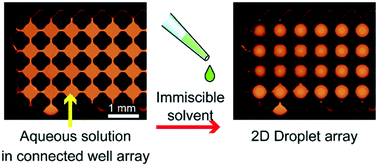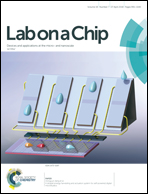Self-generation of two-dimensional droplet array using oil–water immiscibility and replacement†
Abstract
Two-dimensional (2D) microdroplet arrays with indexed sample concentration gradients have been receiving considerable attention for high-throughput biological and medical analyses. However, the preparation of such an array by conventional methods mandates precise pipetting and/or pumping. In this paper, we introduce a method to spontaneously generate 2D-arrayed aqueous droplets using a well array, for which coarse pipetting is sufficient. The wells are connected in rows and columns via narrow channels. Aqueous solutions impregnated in the well array are split into droplets in every single well as a subsequently introduced immiscible solvent self-propagates and divides the solution at the channels. A concentration gradient of the samples can be formed across the connected solution in the well array; once droplets are generated, each droplet possesses a different sample concentration depending on its position in the array. We experimentally determined the optimal well dimensions and solvent species to obtain a high yield of droplet generation. We next demonstrated a 2D droplet array with a two-sample concentration gradient. Finally, the applicability of the system was demonstrated through a cell viability assay using a sample that induced apoptosis. We believe the proposed method contributes to simplification and miniaturization of the system to generate droplet arrays and thus is applicable to biological and medical analysis.



 Please wait while we load your content...
Please wait while we load your content...